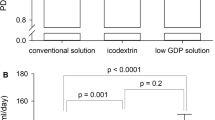Abstract
Background
Inadequate dialysis causes accumulation of toxic residues that may lead to the development of dialysis-associated pericardial effusion, but several other factors could be associated with this abnormality. The purpose of this study was to evaluate clinical risk factors to asymptomatic pericardial effusion in peritoneal dialysis.
Methods
This cross-sectional study included 34 patients aged ≥18 years on peritoneal dialysis for at least 3 months, who showed no symptomatic pericardial effusion, hepatic cirrhosis, neoplasias, lupus or amputations, none in minoxidil use. Asymptomatic pericardial effusion was diagnosed by echocardiography. Risk factors were evaluated by logistic regression and Roc curve. Significance level was set at P < 0.05.
Results
Patient age was 51 ± 15.9 years. Of the 34 patients enrolled, 16 were men and 11 diabetic. Five of them presented pericardial effusion. Logistic regression identifies low hemoglobin level (RR 0.454 CI 95%: 0.225–0.913; P = 0.027), low phase angle (RR 0.236 CI 95%: 0.057–0.984; P = 0.048) and low Kt/V (RR 0.001 CI 95%: 0.0–0.492; P = 0.03) as risk factors to pericardial effusion. Roc curve showed that hemoglobin levels below 12.2 g/dL, Kt/V lower than 1.9 and phase angle lower than 4.5° were the best cutoffs to predict pericardial effusion. Four patients showed these three parameters in the unfavorable range, and all these four patients presented pericardial effusion. The other patient with pericardial effusion had two of these parameters reduced.
Conclusions
These findings corroborate the hypothesis that uremia plays a significant role in the pathogenesis of dialysis-associated pericardial effusion.

Similar content being viewed by others
References
Kim KE, Swartz C (1993) Cardiovascular complications of end-stage renal disease. In: Schrier RW, Gottschalk CW (eds) Diseases of the kidney. Little Brown, Boston
Rutzky EA, Rostand SG (1987) Treatment of uremic pericarditis and pericardial effusion. Am J Kidney Dis 10:2–8
Pace NL, Nestico PF, Schwartz AB et al (1984) Predicting success of intensive dialysis in the treatment of uremic pericarditis. Am J Med 76:38–46
Bailey GL, Hampers CL, Hager EB et al (1968) Uremic pericarditis: clinical features and management. Circulation 38:582–591
Prosser D, Parsons V (1975) The case for a specific uremic myocardiopathy [editorial]. Nephron 15:4–7
Ianhez LE, Lowen J, Sabbaga E (1975) Uremic myocardiophaty. Nephron 15:17–28
Compty GM, Cohen SL, Shapiro FL (1971) Pericarditis in chronic uremia and its sequels. Ann Intern Med 75:173–183
Coltro RS, Ferrarezi S, Matsubara BB et al (2008) Influência da dose de diálise sobre a freqüência de pericardite assintomática em pacientes em terapia dialítica. J Bras Nefrol 30:221–225
Blake PG (2003) Adequação em diálise peritoneal e prescrição da diálise peritoneal crônica. In: Daugirdas JT, Blake PG, Ing TS (eds) Manual de diálise. Médica e Científica, Rio de Janeiro
Lang RM, Bierig M, Devereux RB et al (2005) Recommendations for chamber quantification: a report from the American society of echocardiography’s guidelines and standards committee and the chamber quantification writing group, developed in conjunction with the European association of echocardiography, a branch of the European society of cardiology. J Am Soc Echocardiogr 18:1440–1463
Mushnick R, Fein PA, Mittman N et al (2003) Relationship of bioelectrical impedance parameters to nutrition and survival in peritoneal dialysis patients. Kidney Int 64:S53–S56
Tarng DC, Huang TP (1997) Uraemic pericarditis: a reversible inflammatory state of resistance to recombinant human erythropoietin in haemodialysis patients. Nephrol Dial Transplant 12:1051–1054
Shemin D, Bostom AG, Lambert C et al (2000) Residual renal function in a large cohort of peritoneal dialysis patients: change over time, impact on mortality and nutrition. Perit Dial Int 20:439–444
Rocco MV, Frankenfield DL, Prowant B et al (2002) Risk factors for early mortality in US peritoneal dialysis patients: impact of residual renal function. Perit Dial Int 22:371–379
Paniagua R, Amato D, Vonesh E et al (2002) Effects of increased peritoneal clearances on mortality rates in peritoneal dialysis: ADEMEX, a prospective, randomized, controlled trial. J Am Soc Nephrol 13:1307–1320
Lo WK, Ho YW, Li C et al (2003) Effect of Kt/V on survival and clinical outcome in CAPD patients in a randomized prospective study. Kidney Int 64:649–656
National Kidney Foundation-Kidney Disease Outcomes Quality Initiative (NKF-KDOQI) (2006) Clinical practice guidelines and clinical practice recommendations. Am J Kidney Dis 48:S28–S32
National Kidney Foundation-Kidney Disease Outcomes Quality Initiative (NKF-KDOQI) (2001) Clinical practice guidelines for peritoneal dialysis adequacy: update 2000. Am J Kidney Dis 37:S65–S136
Alpert MA, Ravenscraft MD (2003) Pericardial involvement in end-stage renal disease. Am J Med Sci 325:228–236
Acknowledgments
The authors thank Mariza Branco for English support.
Conflict of interest
The authors declare that they have no conflict of interest.
Author information
Authors and Affiliations
Corresponding author
Rights and permissions
About this article
Cite this article
de Araujo Antunes, A., Caramori, J.C.T., Vannini, F.D. et al. Markers of uremia and pericardial effusion in peritoneal dialysis. Int Urol Nephrol 44, 923–927 (2012). https://doi.org/10.1007/s11255-011-0049-0
Received:
Accepted:
Published:
Issue Date:
DOI: https://doi.org/10.1007/s11255-011-0049-0




